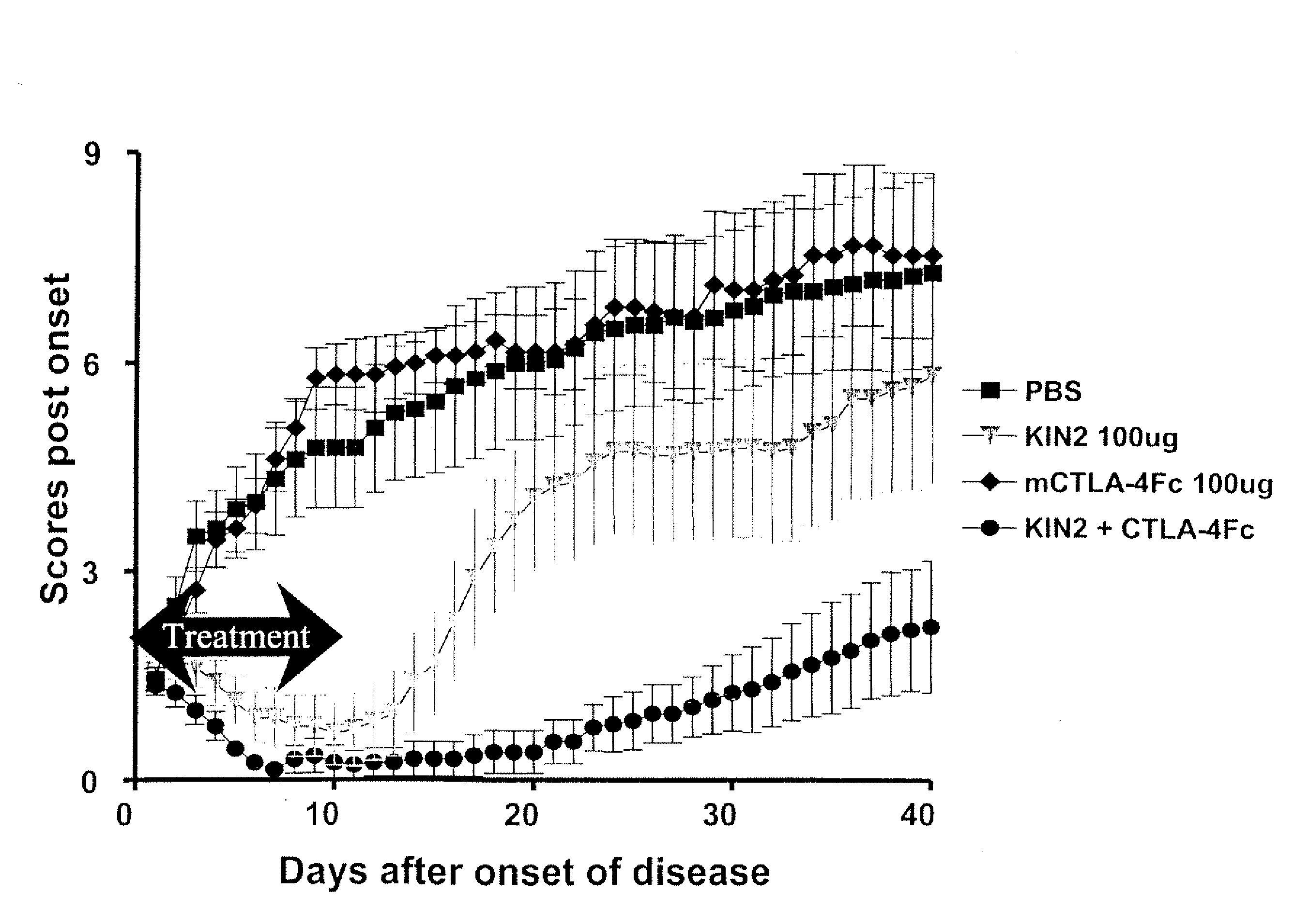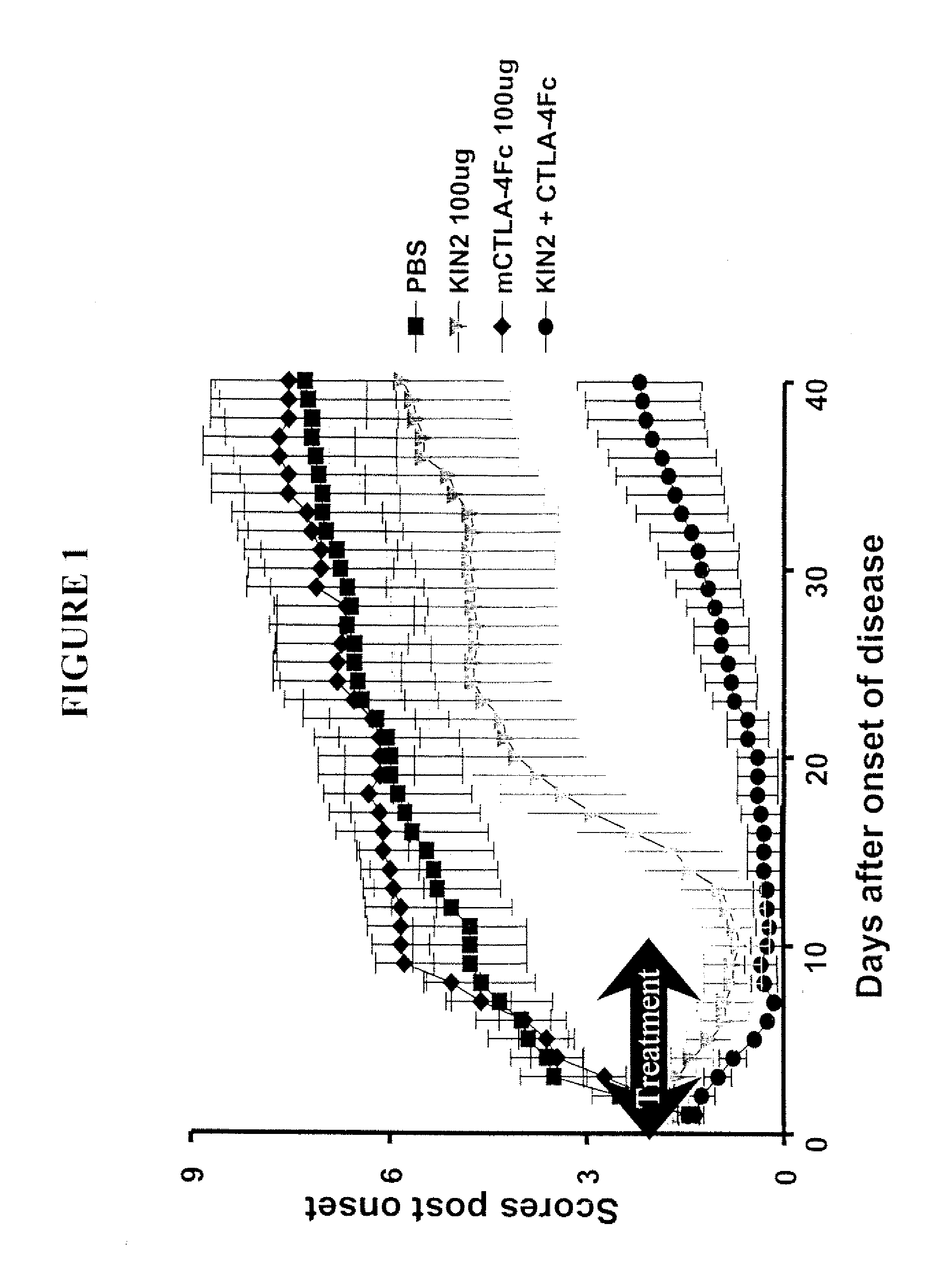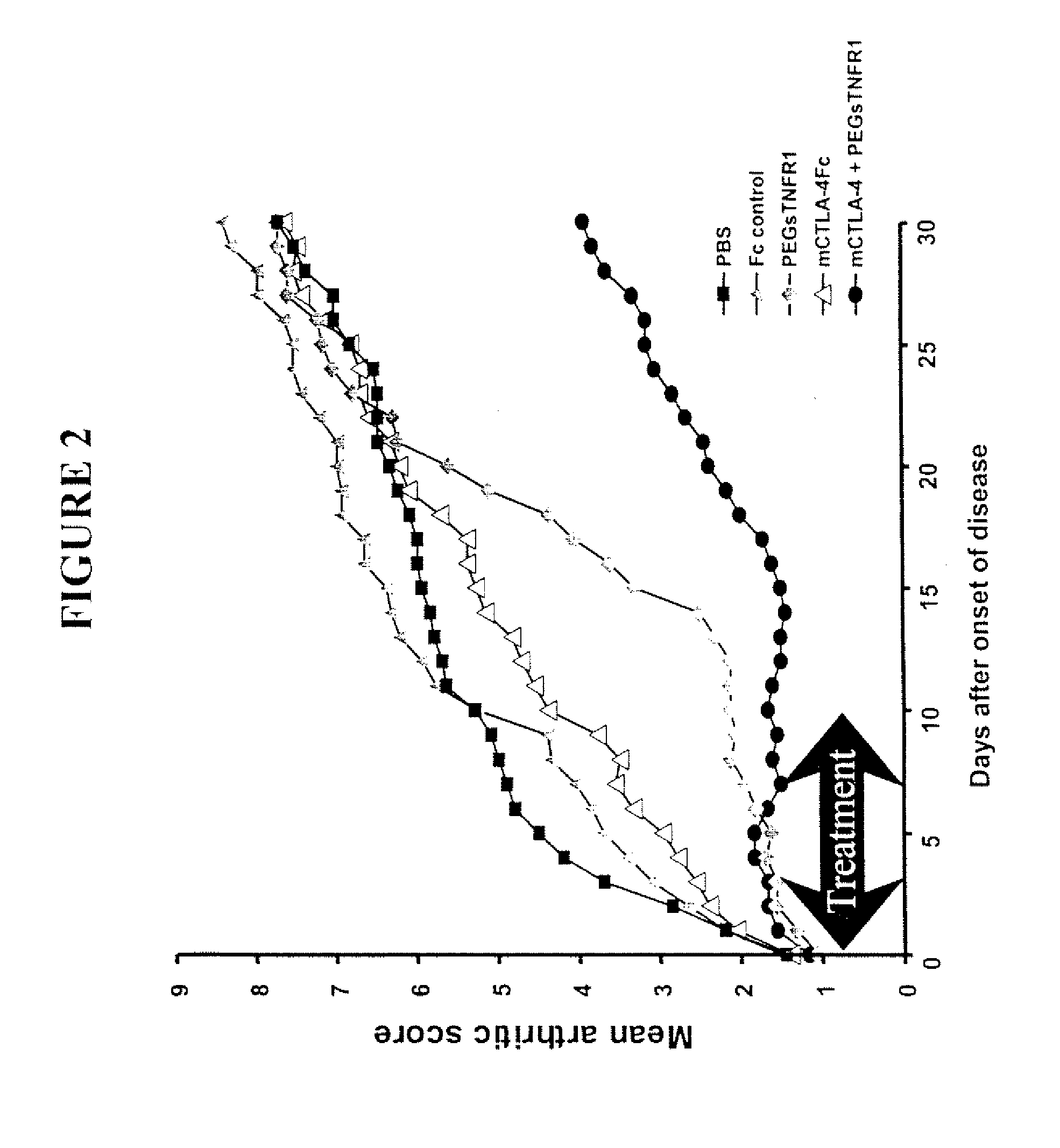Combination Therapy with Co-Stimulatory Factors
a technology of co-stimulatory factors and co-stimulatory factors, which is applied in the field of polypeptides, can solve the problem that recognition events may not fully activate t cells, and achieve the effect of reducing the number of t cells in the body
- Summary
- Abstract
- Description
- Claims
- Application Information
AI Technical Summary
Benefits of technology
Problems solved by technology
Method used
Image
Examples
example 1
Combination Therapy Using KIN2 and CTLA4-Fc in Arthritis-Susceptible B10.RIII Mice
[0327]Murine CTLA4-Fc and KIN2 (SEQ ID NO 2) used in the study were produced at Amgen.
A. Exemplary Preparation of KIN2
[0328]KIN2 may be produced as generally described in U.S. Pat. No. 6,294,170 B1 (the '170 patent). The Fc-IL-1ra fusion protein discussed in the '170 patent is the same as KIN2 discussed herein.
Exemplary Recombinant Human IL-1ra in the '170 Patent
[0329]The '170 patent discusses an IL-1ra gene fragment being enzymatically cleaved from another expression vector and being ligated to the expression vector pAMG21 (European Patent Application No. 96309363.8). The amino acid sequence of IL-1ra is:
(SEQ ID NO. 20)MRPSGRKSSK MQAFRIWDVN QKTFYLRNNQ LVAGYLQGPNVNLEEKIDVV PIEPHALFLG IHGGKMCLSC VKSGDETRLQLEAVNITDLS ENRKQDKRFA FIRSDSGPTT SFESAACPGWFLCTAMEADQ PVSLTNMPDE GVMVTKFYFQ EDE
[0330]The '170 patent discusses that the resulting plasmid pAMG21-IL-1ra was purified and the sequence of the IL-1ra gene ...
example 2
Combination Therapy Using PEG sTNFR-1 and CTLA4-Fc in Arthritis-Susceptible B10.RIII Mice
[0352]PEG sTNFR-1 2.6D, murine CTLA4-Fc, and Fc used in the study were produced at Amgen.
A. Exemplary PEGylation of sTNFR-I
[0353]PEG was added to an sTNFR-1 2.6D molecule to construct PEG sTNFR-1 2.6D. sTNFR-1 2.6D molecules include, but are not limited to, sTNFR-1 2.6D / C105, sTNFR-1 2.6D / C106, and sTNFR-1 2.6D / N105 (SEQ ID NO. 4). PEG may be added to a sTNFR-1 2.6D molecule in a manner similar to how PEG may be added to sTNFR-1 2.6D / N105, as generally described in published PCT Application No. WO 98 / 01555 (PCT '555).
Exemplary Preparation of sTNFR-I 2.6D / N105-t-BuPEG (33 kDa) in PCT '555
[0354]PCT '555 states that to a cooled (4° C.), stirred solution of sTNFR-I 2.6D / N105 (SEQ ID NO. 4) (3.5 mg / ml) in 50 mM sodium acetate, pH 4, is added a 3-fold molar excess of t-BuPEG (mono-t-butoxy-polyethylene glycol, average MW=33 kDa, Shearwater Polymers, Inc.). NaCNBH3 is added to a final concentration of ...
example 3
Combination Therapy Using Viral Vectors Expressing IL-1ra, sTNFR-I and / or CTLA4
[0367]Vector Construction
[0368]Adeno-associated virus (AAV) cloning vectors were based on the pBluescript SK II vector (Stratagene, La Jolla, Calif.). An oligonucleotide linker containing a Bgl II site (CGCGAGATCTTGCGCAAGATCT (SEQ ID NO. 28)) was inserted between the two BssH II sites of pBSSK II. AAV2 genomic DNA (available from the American Type Culture Collection under accession number 37215; see also Laughlin et al. Gene 23, 65-73 (1983)) having flanking Bgl II sites was inserted into the linker. A NruI site and a XhoI site were introduced by site directed mutagenesis at positions 145 and 4530 respectively of the AAV2 nucleotide sequence (Srivastava et. al. J. Virol. 45, 555-564 (1983) and NCBI Accession No. NC-001401). The resulting construct was digested with NruI and XhoI and the AAV2 sequence from nucleotide 146 to nucleotide 4534 was removed. A DNA fragment comprising either a cytomegalovirus (CM...
PUM
| Property | Measurement | Unit |
|---|---|---|
| weight | aaaaa | aaaaa |
| weight | aaaaa | aaaaa |
| weight | aaaaa | aaaaa |
Abstract
Description
Claims
Application Information
 Login to View More
Login to View More - R&D
- Intellectual Property
- Life Sciences
- Materials
- Tech Scout
- Unparalleled Data Quality
- Higher Quality Content
- 60% Fewer Hallucinations
Browse by: Latest US Patents, China's latest patents, Technical Efficacy Thesaurus, Application Domain, Technology Topic, Popular Technical Reports.
© 2025 PatSnap. All rights reserved.Legal|Privacy policy|Modern Slavery Act Transparency Statement|Sitemap|About US| Contact US: help@patsnap.com



